|
 Dermocybe cardinalis Dermocybe cardinalis
SynonymsCortinarius cardinalis
Cortinarius (Dermocybe) sp.
BiostatusPresent in region - Indigenous. Endemic
Images (click to enlarge)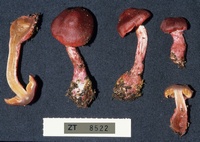
Caption: ZT8522
Owner: E. Horak: © Creative Commons Attribution-Noncommercial 3.0 New Zealand | 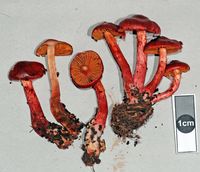
Owner: J.A. Cooper | 
Owner: J.A. Cooper | 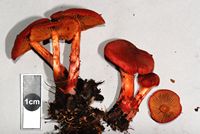
Owner: J.A. Cooper | 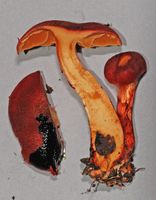
Caption: flesh and KOH reaction on cap
Owner: J.A. Cooper | 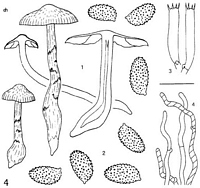
Caption: Dermocybe cardinalis: 1. carpophores. - 2. spores. - 3. basidia. - 4. pileipellis. | 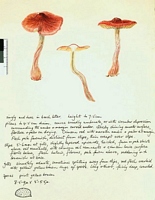
Caption: Watercolour
Owner: G.M. Taylor | 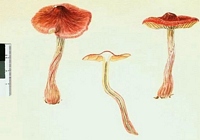
Owner: G.M.Taylor | 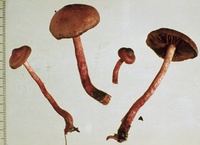
Caption: ZT76-240
Owner: E. Horak: © Creative Commons Attribution-Noncommercial 3.0 New Zealand |
Article: Horak, E. (1988) [1987]. New species of Dermocybe (Agaricales) from New Zealand. Sydowia 40: 81-112.
Description: Pileus -50 mm, at first convex to conico-convex becoming broadly umbonate-expanded to campanulate; crimson red, red-brown, wine red or purple, darker in centre but paler towards margin; viscid to subglutinous when moist, radially fibrillose in dry conditions, striate near margin, hygrophanous, distinct veil remnants lacking at margin. - Lamellae 15-20, 3-7, broadly adnate to emarginate, subdecurrent with short tooth, ventricose, -6 mm wide; apricot, golden yellow or ochre when young turning orange then rust brown in mature specimens, edges concolorous, entire. Stipe -80 x -6 mm, subclavate to fusoid at base (-12 mm diam.), rarely equally cylindrical, single or cespitose; yellow to orange at apex, from cortina to base densely covered with brilliant red-brown, crimson or purple coarse fibrils or agglutinated zones of veil; dry, except veil remnants when fresh, hollow. - Context red in pileus, red-brown in base of stipe. - Odour and taste raphanoid. - Chemical reactions on pileus: KOH - black; HCl, NH3 - negative.
Spore print rust brown. - Spores (-7) 8-9.5 (-10.5) x 4.5-5 (-6) µm, elliptical (to subamygdaliform), minutely verrucose, rust brown. - Basidia 22-37 x 6-8 µm, 4-spored. - Cheilocystidia absent. - Pileipellis a cutis or trichoderm of entangled cylindrical hyphae (-8 µm diam.), terminal cells cylindrical with rounded apex, membranes gelatinized, with pale red-brown to grey-purple plasmatic (rarely encrusting) pigment, more or less insoluble in KOH. - Clamp connections present.
Habitat: On soil in Nothofagus-forests (N. solandri var. cliffortioides, less common under N. fusca-menziesii). - New Zealand.
Notes: In the New Zealand Nothofagus-forests D. cardinalis represents one of the most remarkable species of Dermocybe. The available ecological records indicate that this common purple Dermocybe occurs on both North Island and South Island. It prefers Nothofagus solandri var. cliffortioides as ectomycorrhizal host plant but occasionally it was also observed in association with N. menziesii and N. fusca.
The chromatographic analysis of the pigments revealed that the purple colour of D. cardinalis is actually composed of 10 different anthraquinonoid compounds (KELLER & al., 1988). Among those emodin and dermolutein (and their glucosides respectively) have been detected but the identity of the three principal pigments with highest concentrations still remains unidentified.
|